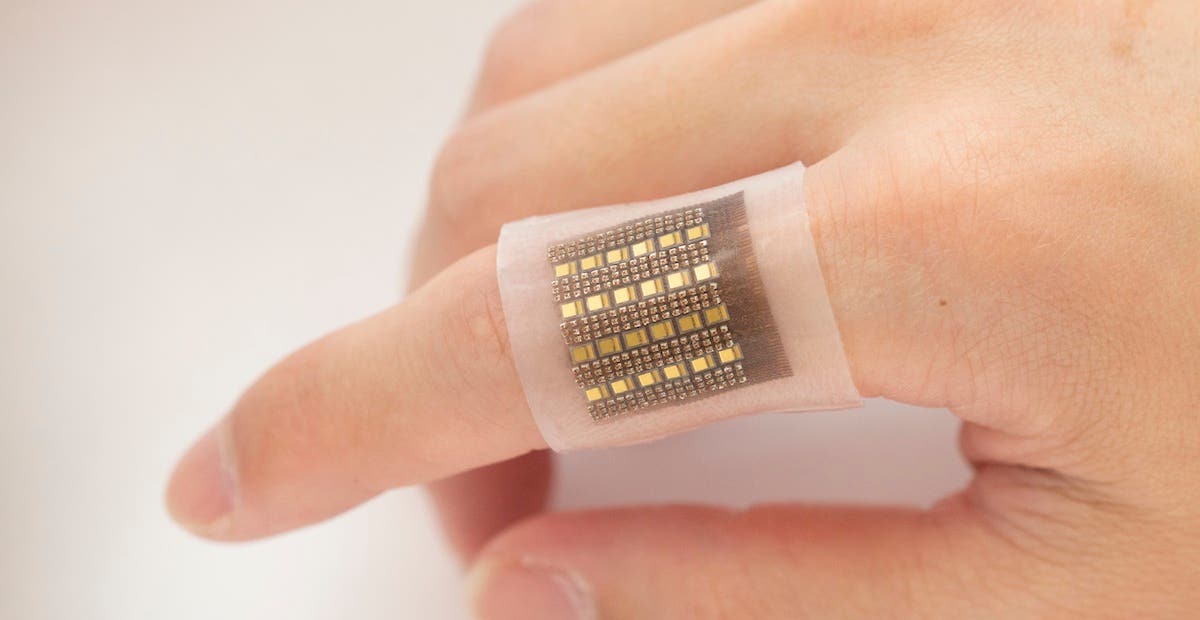Wearable skin patch can spot life-threatening conditions deep within the body
A team of researchers have developed an electronic patch that can monitor biomolecules in deep tissues, including hemoglobin.

[Dec 19, 2022: Katherine Connor, University of California - San Diego]
A photoacoustic sensor could help clinicians diagnose tumors, organ malfunctions and more. (CREDIT: Xiaoxiang Gao for the Jacobs School of Engineering at UC San Diego)
A team of engineers at the University of California San Diego has developed an electronic patch that can monitor biomolecules in deep tissues, including hemoglobin. This gives medical professionals unprecedented access to crucial information that could help spot life-threatening conditions such as malignant tumors, organ dysfunction, cerebral or gut hemorrhages and more.
“The amount and location of hemoglobin in the body provide critical information about blood perfusion or accumulation in specific locations. Our device shows great potential in close monitoring of high-risk groups, enabling timely interventions at urgent moments,” said Sheng Xu, a professor of nanoengineering at UC San Diego and corresponding author of the study.
The paper, “A photoacoustic patch for three-dimensional imaging of hemoglobin and core temperature,” is published in Nature Communications.
Low blood perfusion inside the body may cause severe organ dysfunctions and is associated with a range of ailments, including heart attacks and vascular diseases of the extremities. At the same time, abnormal blood accumulation in areas such as in the brain, abdomen or cysts can indicate cerebral or visceral hemorrhage or malignant tumors. Continuous monitoring can aid diagnosis of these conditions and help facilitate timely and potentially life-saving interventions.
Related Stories
The new sensor overcomes some significant limitations in existing methods of monitoring biomolecules. Magnetic resonance imaging (MRI) and X-ray-computed tomography rely on bulky equipment that can be hard to procure and usually only provide information on the immediate status of the molecule, which makes them unsuitable for long-term biomolecule monitoring.
“Continuous monitoring is critical for timely interventions to prevent life-threatening conditions from worsening quickly,” said Xiangjun Chen, a nanoengineering PhD student in the Xu group and study co-author. “Wearable devices based on electrochemistry for biomolecules detection, not limited to hemoglobin, are good candidates for long-term wearable monitoring applications. However, the existing technologies only achieve the ability of skin-surface detection.”
The new, flexible, low form-factor wearable patch comfortably attaches to the skin, allowing for noninvasive long-term monitoring. It can perform three-dimensional mapping of hemoglobin with a submillimeter spatial resolution in deep tissues, down to centimeters below the skin, versus other wearable electrochemical devices that only sense the biomolecules on the skin surface.
The new, flexible, low form-factor wearable patch comfortably attaches to the skin, allowing for noninvasive long-term monitoring. (CREDIT: Xiaoxiang Gao for the Jacobs School of Engineering at UC San Diego)
It can achieve high contrast to other tissues. Due to its optical selectivity, it can expand the range of detectable molecules, integrating different laser diodes with different wavelengths, along with its potential clinical applications.
The patch is equipped with arrays of laser diodes and piezoelectric transducers in its soft silicone polymer matrix. Laser diodes emit pulsed lasers into the tissues. Biomolecules in the tissue absorb the optical energy, and radiate acoustic waves into surrounding media.
Design, fabrication, and working principle of the soft photoacoustic patch. Schematics of the device structure and the working principle. The patch comprises an array of VCSELs and an array of piezoelectric transducers, interconnected by serpentine copper electrodes. (CREDIT: Nature Communications)
“Piezoelectric transducers receive the acoustic waves, which are processed in an electrical system to reconstruct the spatial mapping of the wave-emitting biomolecules”, said Xiaoxiang Gao, a postdoctoral researcher in Xu’s lab and co-author of the study.
“With its low-power laser pulses, it is also much safer than X-ray techniques that have ionizing radiation”, said Hongjie Hu, a postdoctoral researcher in the Xu group and study coauthor.
Based on its success so far, the team plans to further develop the device, including shrinking the backend controlling system to a portable-sized device for laser diode driving and data acquisition, greatly expanding its flexibility and potential clinical utility.
Design, fabrication, and working principle of the soft photoacoustic patch. Optical photographs of the soft photoacoustic patch under different modes of deformation, including bending on a developable surface, wrapping on a nondevelopable surface, and stretching and twisting. (CREDIT: Nature Communications)
They also plan to explore the wearable’s potential for core temperature monitoring. “Because the photoacoustic signal amplitude is proportional to the temperature, we have demonstrated core temperature monitoring on ex-vivo experiments,” Xu said. “However, validating the core temperature monitoring on the human body requires interventional calibration.”
They are continuing to work with physicians to pursue more potential clinical applications.
For more science and technology stories check out our New Discoveries section at The Brighter Side of News.
Note: Materials provided above by University of California - San Diego. Content may be edited for style and length.
Like these kind of feel good stories? Get the Brighter Side of News' newsletter.
Joseph Shavit
Head Science News Writer | Communicating Innovation & Discovery
Based in Los Angeles, Joseph Shavit is an accomplished science journalist, head science news writer and co-founder at The Brighter Side of News, where he translates cutting-edge discoveries into compelling stories for a broad audience. With a strong background spanning science, business, product management, media leadership, and entrepreneurship, Joseph brings a unique perspective to science communication. His expertise allows him to uncover the intersection of technological advancements and market potential, shedding light on how groundbreaking research evolves into transformative products and industries.



